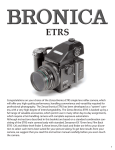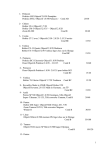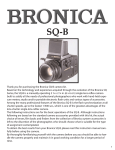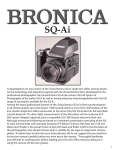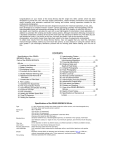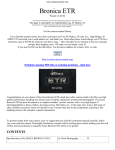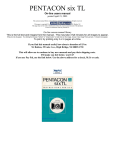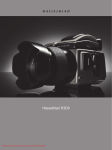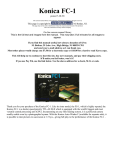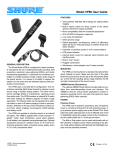Download Zenza Bronica SQ-B Instruction manual
Transcript
SQ-A Congratulations on your choice of the Bronica SQ-A single lens reflex camera that has been developed to give you quality performance, simple handling convenience and extremely useful versatility, such as required for professional photography. The Zenza Bronica SQ-A has been designed to take full advantage of the square 6cm x 6cm medium format. It has also been developed as a complete modular "system" camera, with a very high degree of interchangeability in lenses, finders, focusing screens, film backs, etc. To obtain best results from your camera, we suggest that you read this instruction manual carefully, before you even touch the camera. Thoroughly familiarize yourself with its working parts, before loading your first roll of film, and your pleasure in using the Zenza Bronica SQ-A will be even greater. NOTICE Although instructions following are based on a standard combination consisting of the main camera body with standard lens, film back SQ 120 and waist level finder, the choice of lens, film back and finder is left to the discretion of the photographer, who should choose those items best suited to the type of assignments contemplated. 1 Contents Specifications of the ZENZA BRONICA SQ-A Parts of the ZENZA BRONICA SQ-A 1. 2. 3. 4. 5. 6. 7. 8. 9. 10. 11. 12. 13. 14. 15. 16. 17. 18. 19. 20. 21. 22. 23. 24. 25. 26. 27. 28. 29. 30. Loading the Battery Battery Checking Attachment and Removal of Film Backs Construction of Film Back Film Loading ASA/ISO Film Speed Dial Film Type Indicator Frame Film Advance and Shutter Cocking Exposure Counter Film Unloading Setting the Shutter Speed Dial Shutter Release Button Time (T) Exposure Exchanging Lenses Interchanging Finders Waist-Level Finder and Interchanging Magnifiers Setting the Aperture Focusing Adjustments Distance Scale and Depth of Field Scale Infrared Photography Flash Photography Multiple Exposures Mirror Lock-up Interchanging Focusing Screens Attachment of the Neck Strap Facts about the Battery Pointers on Shooting Care of the SQ-A Depth of Field Table Specifications of Zenzanon-S Lenses Page 3, 4 5 6 6 6, 7 8 8, 9, 10 10 11 11 11 12 12 13 13, 14 14 15 15, 16 16 17 17, 18 18 18 19 19, 20, 21 21 22 23 23 24 25 26, 27 2 Specifications of the ZENZA BRONICA SQ-A Type 6cm x 6cm format lens shutter single reflex camera, with interchangeable lens, film back, finder and focusing screen systems. Frame Size 55.6mm x 55.6mm Film 120/220/135 roll films and Polaroid pack film, with exclusive film backs. Standard Lens Zenzanon-S 80mm F2.8 lens; interchangeable type; 6 elements in 4 groups; multi-layer antireflection coated; 51° angle of view; F22 minimum aperture; helical focusing from infinity to 80cm. Filter Size 67mm diameter on 50mm to 250mm lenses; 95mm diameter on 40mm lens and 500mm lens. Lens Mount Exclusive four-claw Bronica SQ bayonet mount. Focusing Helical focusing system built into each lens; angle of rotation 171° for standard lens. Lens Diaphragm Fully automatic instant reopening lens diaphragm action; equal-distant aperture scale graduations; depth of field previewing. Shutter Electronic control SEIKO #0 between-lens leaf shutter; shutter speeds 8 sec. to 1/500 sec- Multiple Exposure Multiple exposure possible with lever on main camera body. Mirror Lock-Up Mirror lock-up possible with switch lever on the side of main camera body for single or continuous picture taking. 3 Specifications of the ZENZA BRONICA SQ-A (con’t) Film Back Daylight loading interchangeable type; exclusive backs for 120 (12 exposures), 220 (24 exposures), 135 (format sizes of 24 x 36mm and 24 x 54mm) roll films and Polaroid pack films; with ASA/ISO film speed dial on Film Back SQ 120/220/135 and ASA/ISO film speed switch on Polaroid Film Back S coupling to the finders with built-in exposure meter, when attached. Interchangeable finder system. Finder Focusing Screen Flash Synchronization Interchangeable type; Standard type, supplied with camera, has split-image rangefinder spot surrounded by microprism ring and full-area matte screen. Also 6 optional focusing screens are available. X-setting (up to 1/500 sec.) Battery Checking Red-colored LED lights up at front end of finder, outside screen area, when battery check button is depressed; also doubles as shutter closing signal. Battery Single 6-volt silver oxide battery (No. 544, PX28 or 4G13) or alkaline manganese battery (No. A544 or 4LR44.) Dimensions 92mm wide x 109mm high x 179mm long (with standard lens, Film Back SQ 120 and waist-level finder S) Weight 1,500 grams- (with standard lens, Film Back SQ 120 and waist-level finder S) 915 grams- SQ-A main camera body w/ Film Back SQ 120 115 grams- Waist level finder S 470 grams- Zenzanon-S 80mm lens The specifications are subject to change without prior notice. 4 Parts of the ZENZA BRONICA SQ-A Aperture Ring Depth of field scale Flash synch socket Distance scales Focusing ring Lens alignment dot Waist-level finder Focusing hood catch Shutter speed dial Shutter speed scale Magnifier Back cover release button (left) Back cover release button (right) ASA/ISO film speed dial Exposure counter Shutter release button Multiple exposure lever Neck strap eyelet Lens release button Film winding crank Battery check button Finder release button Depth of field preview lever Film plane mark Spool holder Dark slide slit Manual film winder Cable release socket Shutter release button locking ring Neck strap eyelet Film back release button Mirror lock-up switch lever Time exposure lever Film type indicator frame Set screw Flash synch contact Accessory mounting guide Tripod socket (1/4” screw) Battery chamber cover Battery chamber button 5 1. Loading the Battery The electronically controlled shutter will not work without loading the battery. The shutter will be mechanically controlled when the battery is not loaded and will be released at 1/500 sec., regardless of the setting on the shutter speed dial. Use one 6 volt silver oxide battery or alkaline-manganese battery. * The battery may be obtained at any photographic equipment or electrical appliance shop. A. Depress the battery chamber button with your finger and, at the same time, move the battery chamber cover in the arrow-indicated direction. The cover will come off easily. B. Coincide the plus (+) and minus (-) marks on the battery with similar polarity indications in the battery chamber. Then, push in the battery. Insert the battery chamber cover in, the BATTERY end first, and then move the cover in the other direction (opposite to the arrow indication) until it locks. * The shutter will be mechanically-controlled (at 1/500 sec.) when the battery is loaded with polarity marks reversed. 2. Battery Checking A red-colored battery check LED lights up outside the focusing screen area, (central front of finder), when the battery check button is pressed. This means the battery is loaded properly and there is sufficient power for operations. * If the LED does not light up; (1) the battery is not loaded properly or, (2) the battery is completely drained and should be exchanged. 3.Attachment and Removal of Film Backs The film back is a film chamber that can be attached or detached freely. This permits a free exchange of film types even during shooting sessions. The main camera body and film back are fully coupled, upon connection. Therefore, always turn the film winding crank completely one time, upon attaching the film back. 6 3.Attachment and Removal of Film Backs If winding is not possible, all preparations for taking pictures have been completed. But, if winding is possible, rotating the film winding crank until it stops will automatically take care of the incomplete action, even if the shutter is uncocked or film is not advanced. Thus, it's always possible to choose the film type most suited for the shot, even midway in the roll. A film speed dial is available on the film backs and can be used for setting the film speed of the film loaded in the film back. This will, furthermore, automatically couple when the finder with built-in exposure meter is attached to the main camera body. This should be very convenient when using films of different sensitivities in various film backs. Film backs are available optionally. Please select a film back best suited for shooting conditions. * See instructions supplied with Film Back SQ 135 for proper use of the 135 roll film. A. To remove the film back from the main camera body, insert the dark slide into the dark slide slit, as illustrated, with the mark on the dark slide at the top end. Push it all the way in. B. Depress the film back release button and the lower end of the film back can be removed, as illustrated. Simply shift the film back up slightly and pull it away. * The dark slide cannot be withdrawn from the film back when the film back is not attached to the main camera body. * The dark slide must be withdrawn from its slit, upon attachment of the film back to main body, or otherwise the shutter cannot be released. Furthermore, there is a danger of the film accidentally becoming detached from the main body, should the dark slide be left in its slit while the camera is being carried. Therefore, make it a rule to withdraw the dark slide promptly upon attaching the film back to the main body. C. To attach the film back to the main camera body, simply insert the latches at the upper end of the film back into the attachment openings at the upper end of the main camera body. Then, press the lower end of the film back against the main body until it locks securely. 7 4. Construction of Film Back A. The film back consists of a film holder and a film back frame, with exclusive film backs available for 120 and 220 roll films. The film holder has an insert or frame for loading film, as well as a built-in winding mechanism. B. The film back frame has a base with a dark slide slit and a back cover with an ASA/ISO film dial and a film type indicator frame. The film back frame completely encloses the film holder and shields it from outside light, as well as connecting it to the main camera body and also coupling with the finders with built-in exposure meters. 5. Film Loading A. To open the back cover, squeeze the left and right back cover release buttons, in the arrow-indicated directions, at the same time and the back cover will open. B. The film holder can be taken out for film loading, upon opening the back cover. C. There are two spool holders on the film holder. The top one is for the fresh film spool and the bottom is for the empty take-up spool. The left side shaft of spool holder can be opened by pushing the fresh film spool outward in the arrow-indicated "A" direction. Therefore, insert the right end of the spool on to the right side shaft, which is fixed, and then close the left side holder (shaft) that will engage the spool. * The spool holders on the left side will be locked securely when the back cover is closed. 8 5. Film Loading (con’t) D. After loading the fresh film spool properly, draw out the leading end of the film and turn it across the film pressure plate (as illustrated). Run it down and turn it over to the take-up spool. Insert the leading end into the slit of the take-up spool and wind slightly until securely engaged. * The inside black surface of the leader must face out when running across the pressure plate, in this case. E. Lift up the hinged flap and rotate the manual film winder on the right side of the film holder in the arrow-indicated direction. When starting point, or arrow-mark, on the leader is aligned with the triangular start-mark on the top left side of the film holder, stop rotation. F. The starting point, or arrow mark, can also be aligned with the start-mark, with the film holder loaded in the film back. Simply rotate the film-winding crank on the main camera body, in this case. This method is preferred since there will be coupling with the main camera body mechanism, from the beginning. * If the film is not advanced when the film-winding crank is rotated, the film holder is not inserted properly and/or the main camera body may be set for multiple exposures. In the latter case, return the multiple exposure lever to an upright or vertical position. (See "22. Multiple Exposures"). G. Close the back cover by pressing it firmly against the base of the film back, as illustrated. The back cover will automatically close and lock. The same operation will close the back cover when the film back is detached from the main body. 9 5. Film Loading (con’t) H. Upon loading the film, rotate the film-winding crank until it stops to place the first frame into place for taking the picture. The exposure counter will also change from "S" to "1", while the shutter will also be cocked. When the film back is detached from the main camera body for film loading, the manual film winder is used for advancing the film. The film will stop when it is in place for the first exposure, with the exposure counter also changing to "1". However, it will be possible to rotate the manual film winder and it should be rotated two or three times more, in order to take up any slack in the loaded film. * When loading 220 roll film in the Film Back SQ 220, do not mistake the dotted line before the arrow-mark for the start-mark. 6. ASA/ISO Film Speed Dial To set the film sensitivity of the film loaded in the film back, revolve the ASA/ISO film speed dial with a slight lifting action, as illustrated, and set the film speed scale to the index. There are click-stops at 1/3rd increments, in this case. (The dial can be revolved in either direction.) * The ASA/ISO film speed dial is automatically coupled to the finder with built-in exposure meter, when attached. 10 7. Film Type Indicator Frame Upon loading the film, tear off the end flap from the empty film package and insert it in the film type indicator frame. This will help you keep track of the film loaded in the film back, even when two or more film backs are used with different films. At the same time, set the film speed with the ASA/ISO film speed dial. This will come in handy when using the finder with built-in exposure meter. 8. Film Advance and Shutter Cocking Rotating the film-winding crank completely one time, in the forward direction, will advance the film one frame and, at the same time, cock the shutter, with the winding action stopping automatically. On the other hand, short, rapid strokes, up to an accumulated full rotation, will also do the job. * Please make sure that the mirror lock-up switch lever is set at "N" opposite the index when taking pictures. It does not require mirror lock-up. 9. Exposure Counter The exposure counter shows the number of frames exposed or, in other words, is an additive type. Starting from "S", the counter on the Film Back SQ 120 shows numbers from 1 to 12, while Film Back 220 shows numbers from 1 to 24. The letter "S" and numbers "12" and "24" are orange-colored, while all other numbers are white. 11 10. Film Unloading A. After the 12th exposure of the 120 roll film (24th exposure of the 220 roll film), the film-winding crank will turn freely with further rotations. Therefore, continue rotating the film-winding crank until the remaining film and all leader paper is wound up on the take-up spool. Open the back cover when winding action becomes very light. B. Remove the film holder and, while preventing the loose film from unwinding, take out the take-up spool. Seal the exposed film and return it to its original box until development. * Load and unload film away from direct sunlight and/or strong illumination. 11. Setting the Shutter Speed Dial A. The shutter speed scale is viewed in its window over the shutter speed dial. The numbers on the scale are shutter speed settings, with numbers 1 to 8S full numbers and numbers 2 to 500 fractions of a second. For example, "8S" is 8 sec., "2S" is 2 sec., and "500" is 1/500 sec., but no intermediate setting between click stops are possible. * The shutter is released at 1/500 sec., regardless of the setting when the battery is not loaded or is completely drained. B. The numbers on the scale are color-coded in orange and white. Orange-colored numbers are full number settings of 1 second and longer while white-colored numbers are settings from ½ to 1/500 second. There is no B (bulb) setting. See time (T) exposures. Shutter speed settings can be changed before or after shutter cocking. 12 12. Shutter Release Button A. Depress the shutter release button with the ball of the finger. Use a smooth, gentle action and press all the way in, without using strength or jerking. * A red-colored LED will light up in the front central area of the finder and will indicate that the shutter has closed, in this case. The signal is specially valuable when using slow shutter speeds, as it indicates completion of the exposure. B. Safety Lock- The shutter release button can be locked to prevent accidental operations. Simply rotate the locking ring 60° clockwise, which will place a red dot on the side. The cable release socket will also be locked, in this case. To release the safety lock, rotate the locking ring counter-clockwise and place the red dot diagonally lower. The shutter cannot be released in the following cases:1. Shutter release button is locked. 2. Dark slide is inserted. 3. Film winding crank has not been rotated fully. (Same when exposure counter is still between "S" and "1".) 4. Shutter is not cocked. 5. Lens is not properly attached. (Same with extension tubes and bellows.) 6. Lens release button is being depressed. 7. All frames (12 on 120 roll film and 24 on 220 roll film) have been exposed already. * If film-winding crank is rotated while depressing shutter release button, the shutter will be released when the winding action is completed. * A cable release or self-timer can be used with the cable release socket on the main body. 13. Time (T) Exposures Time exposures are made with the time exposure lever on the lens, regardless of the setting on the shutter speed scale. However, the lever is locked to prevent accidental movement and must be unlocked for use. 13 13. Time (T) Exposures (con’t) A. Unscrew the set screw on the time exposure lever until further revolution is impossible, which will permit the lever to be moved freely. * Except for time exposures, always shift the time exposure lever so that "A" is visible on the lens barrel and keep it locked with the set screw to prevent accidental movement. B. Next, cock the shutter with the film-winding crank and then shift the time exposure lever to the left (looking from the body towards the lens), which will expose a red-colored "T" on the barrel. The shutter will stay open when the shutter release button is depressed in this condition. The shutter is closed by shifting the time exposure lever in the opposite direction and exposing the letter "A" once more. 14. Exchanging Lenses The lens cannot be attached or detached unless the shutter is cocked. Therefore, first, rotate the film-winding crank and cock the lens shutter. A. To attach the lens to the main body, align the orange dot on the main camera body and the red dot on the lens, and then insert the lens fully into its mount. Rotate in the counter-clockwise direction until it stops, with an audible click, which indicates that it is securely locked. B. To detach the lens, the film-winding crank must also be rotated to cock the lens shutter first. Then, press the lens release button down and, at the same time, rotate the lens in the clockwise direction until it makes a full stop. At this point it will be possible to detach the lens. 14 15. Interchanging Finders A. The finder can be interchanged, with other optional finders, to match shooting conditions to photographic conditions. To attach the finder, align the front end of the finder with the front end of the finder frame on top of the main camera body, as shown. Then, gently lower the finder and, when well seated, slide forward until it locks. B. To detach, simply depress the finder release button, while, at the same time, sliding the finder backwards where it can be taken up. 16. Waist-Level Finder and Interchanging Magnifiers A. The focusing hood of the waist-level finder is opened by pushing up on the focusing hood catch at the rear end of the folded waistlevel finder. * There is no standard finder for the Bronica SQ-A, with the user having a choice of several finders. Instructions are based on the waistlevel finder because of its popularity. B. The magnifier is flipped into viewing position by simply sliding the release lever in the arrow-indicated direction. To store the magnifier, simply push it down until it catches. * The magnifier can be exchanged for one matching the eyesight of the user. C. To close the focusing hood, first, push down the magnifier (if it is in viewing position). Next, press in both side frames, as illustrated, and at the same time, press the front frame back towards the rear. The focusing hood will automatically be folded down. 15 16. Waist-Level Finder and Interchanging Magnifiers (con’t) D. The standard magnifier supplied with the waist-level finder has a power of -1.5 diopters, which can be exchanged for others with powers of -4.5, -3.5, -2.5, -0.5, +0.5, and +1.5 diopters. These optional accessories should be purchased to suit the user's eyesight, if necessary. Simply rotate the magnifier frame in the counter-clockwise direction to unscrew. Attach in the reverse manner. 17. Setting the Aperture A. The aperture ring is rotated, in either direction, to set the required f/number opposite the white index dot. The aperture ring click-stops at the numbered settings. Intermediate settings are also possible. * Intermediate settings cannot be used when the finders with built-in exposure meters are used. B. All interchangeable lenses for the Zenza Bronica SQ-A have fully automatic lens diaphragms, which means that the focusing screen is always viewed at the full aperture, with the brightest possible image. However, depressing the depth of field preview lever will stop the lens diaphragm down to the pre-selected lens opening and permit the photographer to check the depth of field effect on the focusing screen. * The aperture ring must not be adjusted while the depth of field preview lever is being depressed. * If exposure measurements are taken with the depth of field preview lever depressed, when using finders with built-in exposure meters, the shutter speed setting indicated will cause over-exposure. This is because proper exposures are obtained with exposure measurements made at full aperture. 16 18. Focusing Adjustments A. The lens is focused on the subject by rotating the focusing ring in either direction, while checking the effect on the microprism / splitimage rangefinder spot in the center of the focusing screen (standard type). B. The central split-image spot splits the image into two, with the upper and lower halves separated horizontally when the lens is out of focus. When in focus, however, the two halves will coincide with the displacement disappearing. The microprism ring surrounding the central spot can also be used for checking the sharpness of the focused image, since the image will glitter when the lens is not focused. The surrounding full-area matte surface can also be used for checking image sharpness. 19. Distance Scale and Depth of Field Scale A. Distance scales on the Zenzanon-S lenses can be used for focusing at the required distance actually focused. Simply rotate the focusing ring and set the required distance opposite the orange-colored index, which will adjust the lens for the required distance. B. There is an apparent zone of sharpness, both in front and back of the focused subject, which is known as the depth of field. The depth of field scale shows the zone of apparent sharpness at any lens opening or distance and can be utilized for quickly and simply ascertaining the depth of field. The depth of field scale is next to the distance scales and is made up of identical pairs of apertures on both sides of the orange-colored distance index. 17 19. Distance Scale and Depth of Field Scale (con’t) These identical pairs of apertures indicate the distance that will be in focus at these lens openings. For example, if the 80mm lens is focused at a distance of 3m, it can be seen from the depth of field scale that the zone will extend from 2 to 7 meters (6 ft. to 23 ft.), when a lens opening of F/22 is used. * See the depth of field table for the Zenzanon-S 80mm lens. 20. Infrared Photography In infrared photography, some adjustment must be made in the focus in order to retain sharpness on the film, because the invisible infrared rays are no longer in wavelengths than the visible rays used for focusing. For infrared photography1.Use an R filter or equivalent with an infrared (black and white) film. 2.The red-colored line, next to the orange-colored distance index, is the infrared index. 3.After focusing in the normal manner, re-set the distance indicated by the orange-colored distance index to the infrared index, by shifting the distance ring. 4.Follow instructions enclosed with the infrared film and filter and to be on the safe side, make several bracketing shots. In general, more exposure rather than less seems to be a safe guide. 21. Flash Photography A. Always use flash cords with a standard PC type plug. When detaching the flash cord, grip the plug firmly and pull it out straight, instead of using a twisting action. B. The lens shutter of the Zenzanon-S lens has a X-setting for flash synchronization, which means that electronic flash units will synchronize at all shutter speed settings, up to the fastest 1/500 second. This means that flash fill-in for daylight shots can also be made very easily. 18 22. Multiple Exposures A. To make up multiple exposures, rotate the film winding crank (to advance the film and cock the shutter) and then turn the multiple exposure lever in the clockwise or arrow-indicated direction, which will expose a red mark. When set in this manner, the shutter can be released and cocked any number of times, without advancing the film. B. Upon taking the multiple-exposed picture, be sure to return the multiple exposure lever back to its vertical position and cover the red mark. Otherwise, there will be additional multiple exposures on the same frame. 23. Mirror Lock-Up A. The mirror lock-up switch lever has three settings, or N, S and C, with the lever rotated to set N (normal) to the index for shooting without locking up the mirror, S (single frame) and C (continuous) for shooting with the mirror locked up. * On shooting with mirror locked up, always use Manual mode when the AE Prism Finder S is attached. B. For shooting with the mirror locked-up, first cock the shutter. Then, rotate the mirror lock-up lever in the arrow-indicated direction and coincide S or C to the index. The lens shutter will close completely and the reflex mirror and film safety plate will swing up. C. The shutter will be released when the shutter release button or cable release is depressed. 19 23. Mirror Lock-Up (con’t) D. When S is set to the index with the mirror lock-up switch lever, the lever will automatically return to N, with the next film advancing and shutter cocking action. And, following shots will be normal. E. When C is set to the index with the mirror lock-up switch lever, the lever will not return to N with the next film advancing and shutter cocking action. Therefore, shooting with the mirror locked-up will be possible any number of times. * When the film winding crank is revolved, after all 12 or 24 exposures, film winding only in the normal manner, will not take place, but the shutter will be released with the mirror locked up, any number of times. Therefore, always return the mirror lock-up switch lever to N after the last 12th or 24th exposure, and wind the film in the normal manner. F. To return to normal shooting with the mirror locked up in the continuous mode, rotate the mirror lock-up switch lever and set S or N to the index, then cock the shutter. When shooting is suspended, after mirror lock-up in the S or C mode, by rotating the mirror lock-up switch lever to N, one of the following actions will take place1. Shutter will be released, or 2. Shutter will not be released; furthermore, it will not be possible to press the shutter release button. * In order to prevent the above, shooting should be continued, in the following manner; a. Advance the film and cock the shutter. In this case, a single exposure will be wasted. 20 23. Mirror Lock-Up (con’t) b. Cover the lens and take one blank exposure, as follows: First, return the mirror lock-up switch lever to N setting. Then, use the multiple exposure lever and expose the frame. Finally, after exposing the frame, reverse the multiple exposure lever. (See 22. Multiple Exposures.) c. Utilize film back interchangeability and expose the frame after removing the film back from the main body. Then, continue shooting, according to "b" preceding. (See 3. Attachment and Removal of Film Back.) 24. Interchanging Focusing Screens A. The focusing screen can be exchanged, depending on the type of photographic work being undertaken. First, remove the finder attached to the main camera body. Then, move the screen removal levers on both sides in the arrow-indicated directions, as illustrated. Then, using a pincer or similar tool, lift up the screen with the protrusion at the rear end. B. To install the focusing screen, nest the protrusion at the rear end of the screen in the corresponding groove on the main camera body. Then, slide both screen removal levers forward to secure the focusing screen. * Seven types of focusing screens are available for the Zenza Bronica SQ-A. Microprism / split-image Microprism Matte Split-image Grid-lines Matte (for 135 film) Microprism / split-image (for 135 film) 21 25. Attachment of the Neck Strap A. First, insert the U-shaped ring into the neck strap eyelet, as illustrated. B. Next, place the plastic ring cover over the u-shaped ring, as illustrated. C. Next, thread the neck strap through the plastic ring cover (and the U-shaped ring) and pull it out, as illustrated. D. After adjusting the length of the neck strap, pass the leading end of the strap through the buckle, as illustrated, which will fix it securely. * There should be no slack between the buckle and the plastic ring cover, or in "A" section, which means that both straps must be of the same length at this point. 22 26. Facts about the Battery The battery supplies power for the various electronic control mechanisms incorporated in the Zenza Bronica SQ-A. When used incorrectly, there is a possibility of the wrong exposure being set to the camera and/or the camera not operating. Be sure to use and store the battery correctly for obtaining optimum performance from it at all times. Take the battery out of the battery chamber when storing the camera. Leaving the battery in the camera for a long time, without using it, can lead to leakage problems and result in poor contact. Discard a battery with leakage or corrosion and thoroughly clean out the battery chamber before inserting a new battery. Clean the contacts of the battery chamber and battery with a soft cloth. Don't use sandpaper or emery paper. Don't throw the battery into a fire or hit it strongly, as there is danger of explosion. Either a silver oxide battery (No. 544/PX28/4G13) or an alkaline manganese battery (A544/4LR44) is used with the Zenza Bronica SQ-A. Both have very good cold weather resistance. However, there is a tendency for performance to drop when the temperature falls below 0° C (32° F). Therefore, make it a rule to use a new battery and/or keep replacement batteries on hand for shooting outdoors in freezing weather. Keep the battery (and camera) under cover, next to the body, and load just before beginning the session and/or, preferably, use the optional Remote Camera Battery Pack E. 27. Pointers on Shooting The shutter cannot be cocked when the film is not loaded in the film back. The use of the multiple exposure lever will, however, permit you to cock the shutter, in such instances. This feature is, of course, very convenient for familiarizing yourself with the camera and for testing the shutter in flash photography. (See 22. Multiple Exposures.) Battery power is not consumed when time exposures are made. The voltage will drop when the camera is used for long shooting sessions in freezing weather. Insert a new battery or keep a spare on hand, for such occasions. Furthermore, keep such batteries in an inside pocket. The focusing screen is detached for exchanging with other types. Do not place trimming masks or tapes on the bottom surface of the screen, as this will lead to inaccurate focusing. A red LED will flash above the focusing screen area and signal closing of the shutter when taking the picture. Wait for this signal, especially at slow shutter speeds, before rotating the film winding crank. It should be remembered, when taking pictures, that the final print will not be a square format, especially in the economy size, but will be cut down on both sides or at the top and bottom. 23 28. Care of the SQ-A Restrict cleaning of the reflex mirror to blowing or brushing with the blower brush or a soft camel hair brush. Don't touch the surface with your fingers or a cloth. Use lens cleaning tissue and liquid to clean the surface of the lens. Do not use silicon-coated cloth for this purpose, as it will prove detrimental to the lens coating. Clean the plastic focusing screen in the same manner. Don't touch the surface as you may leave fingerprints. Protect your camera from temperature changes which can result in moisture condensation, frost, etc., inside the body, leading to rusting of metallic parts. Protect your camera from impact and vibrations, too. Upon attaching the film back, always pull out the dark slide from its slit. Always protect the lens with its cover, when carrying the camera. Clean the camera and the lens very carefully after using it outdoors or in wet weather or at the seashore. Wipe the camera carefully with a well-wrung damp cloth, using fresh water, if exterior is affected by salty air. Then, wipe it dry with a soft, dry cloth. If necessary, send it out for a quick inspection at an authorized repair station. If the equipment is not being used for a long period, store everything in tin-lined containers, with plenty of desiccant, such as silica gel. Store the equipment in a cool, dry, and well ventilated (but not windy) place. Do not thread too strongly when using a longer-than-standard tripod screw, as you may damage the body. * Both main camera body and lens must be in the "cocked" condition to attach or remove the lens. In other words, when "cocked" the cocking pin of the lens will be set between the red band and green dot, while the cocking pin of the main body mount will be set to the green-colored dot. When not set in the above manner, the cocking pin of the detached lens can be set by moving it manually, while the cocking pin of the main body mount will be set by revolving the film winding crank. 24 29. Depth of Field Table F-numbers oo 10 5 3 2 1.5 1.2 1.0 0.9 0.8 2.8 oo 13.3 5.68 3.22 2.09 1.55 1.23 1.02 0.92 0.81 39.8 8.03 4.46 2.81 1.92 1.45 1.17 0.98 0.89 0.79 oo 15.1 5.99 3.32 2.13 1.57 1.24 1.03 0.92 0.82 28.9 7.47 4.29 2.74 1.89 1.44 1.16 0.97 0.88 0.78 oo 19.3 6.53 3.47 2.19 1.60 1.26 1.04 0.93 0.82 20.5 6.77 4.06 2.64 1.84 1.41 1.15 0.96 0.87 0.78 oo 31.3 7.48 3.72 2.28 1.64 1.29 1.06 0.94 0.83 14.5 5.97 3.76 2.52 1.78 1.38 1.13 0.95 0.86 0.77 oo 287 9.44 4.13 2.42 1.71 1.33 1.08 0.96 0.85 10.3 5.13 3.42 2.36 1.71 1.34 1.10 0.93 0.85 0.76 oo oo 15.0 4.90 2.66 1.82 1.39 1.12 0.99 0.87 7.28 4.27 3.02 2.18 1.61 1.28 1.06 0.91 0.83 0.74 oo oo 97.0 6.67 3.08 2.00 1.48 1.18 1.04 0.90 5.17 3.46 2.60 1.96 1.49 1.21 1.01 0.87 0.80 0.72 4 5.6 8 11 16 22 F-numbers 2.8 4 5.6 8 11 16 22 Meters Feet oo oo 131 oo 94.8 oo 67.1 oo 47.5 oo 33.7 oo 23.9 oo 17.0 30 38.7 24.5 43.5 22.9 53.4 20.9 79.2 18.6 25.1 16.1 oo 13.5 oo 11.0 15 16.8 13.5 17.7 13.0 19.1 12.4 21.5 11.5 26.3 10.6 38.3 9.41 110 8.16 10 10.8 9.34 11.1 9.11 11.6 8.79 12.4 8.38 13.8 7.85 16.5 7.22 22.7 6.48 7 7.35 6.68 7.49 6.57 7.72 6.41 8.06 6.19 8.61 5.91 9.53 5.55 11.2 5.12 5 5.17 4.84 5.23 4.79 5.34 4.71 5.49 4.59 5.73 4.44 6.10 4.25 6.72 4.01 4 4.10 3.90 4.14 3.87 4.20 3.82 4.29 3.75 4.43 3.65 4.64 3.53 4.97 3.36 3.5 3.57 3.43 3.60 3.40 3.65 3.36 3.71 3.31 3.81 3.24 3.96 3.14 4.19 3.02 3 3.05 2.95 3.07 2.93 3.10 2.90 3.15 2.87 3.21 2.82 3.31 2.75 3.46 2.65 25 30. Specifications of the Zenzanon-S Lenses 40mm F4 50mm F3.5 80mm F2.8 105mm F3.5 150mm F3.5 No. of group-element 8 - 11 8 - 10 4-6 4-6 5-5 87 76 51 41 30 4 - 22 3.5 - 22 2.8 - 22 3.5 - 22 3.5 - 22 0.4 0.5 0.8 0.85 1.5 (1.3 ft) (1.6 ft) (2.6 ft) (2.8 ft) (4.9 ft) 95 67 67 67 67 83 62 52 60 61 Weight (grams) 660 560 470 540 590 Equivalent focal length in 35mm format camera (mm) 21 28 45 58 85 Angle of View Apertures Minimum focusing distance (M) Filter Size (mm) Overall length (mm) 26 30. Specifications of the Zenzanon-S Lenses No. of group-element (con’t) 200 mm F4.5 250 mm F5.6 500 mm F8 Tele-converter S 2X 5-5 5-5 6-7 5-6 22° 30’ 18 9 4.5 - 32 5.6 - 32 8 - 45 2.5 3 8.5 (8.2 ft) (9.8 ft) (28 ft) 67 67 95 97 129 255 53 740 870 1890 500 105 135 280 Angle of View Apertures Minimum focusing distance (M) Filter Size (mm) Overall length (mm) Weight (grams) Equivalent focal length in 35mm format camera (mm) 27



























